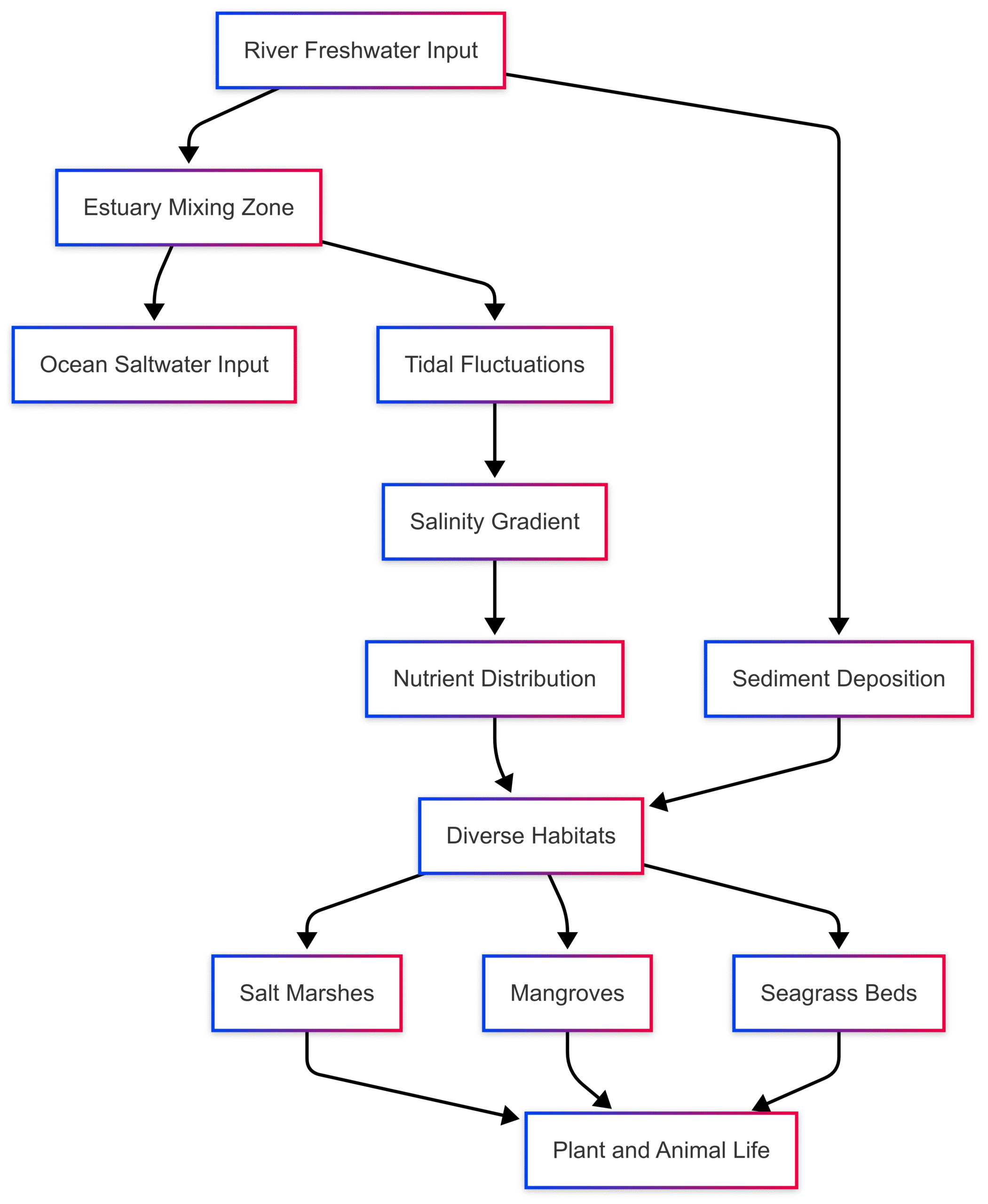Exploring the Wonders of Estuaries
Discover the wonders of estuaries: vital ecosystems blending freshwater and saltwater, supporting biodiversity, and offering ecological and economic benefits.
Exploring the Wonders of Estuaries
Estuaries are among the most dynamic and vital ecosystems on Earth, where freshwater rivers meet the salty embrace of the ocean. These semi-enclosed coastal waters create unique environments that support an extraordinary array of life, provide critical ecological services, and sustain human communities. Often called the “nurseries of the sea,” estuaries are bustling hubs of biodiversity, serving as breeding grounds for marine species, filtering water, and protecting coastlines. Yet, they face significant threats from human activities and climate change. This article dives deep into the marvels of estuaries, exploring their formation, biodiversity, ecological and economic importance, threats, and conservation efforts, while highlighting their role in sustaining life and livelihoods.
What Are Estuaries?
Estuaries are partially enclosed bodies of water where freshwater from rivers and streams mixes with saltwater from the ocean. This blending creates a gradient of salinity, ranging from nearly freshwater at the river’s mouth to fully saline at the ocean interface. Estuaries come in various forms, including bays, lagoons, harbors, and sounds, and are often shielded from the ocean’s full force by features like mudflats, sandspits, or barrier islands. Scientists classify estuaries based on their geology and water circulation patterns, which influence their unique characteristics.
The mixing of fresh and saltwater creates a nutrient-rich environment, fostering high productivity. Estuaries are shaped by tidal movements, river flows, and sediment deposition, resulting in diverse habitats like salt marshes, mangroves, seagrass beds, and oyster reefs. These habitats support a complex web of life, making estuaries critical to both marine and terrestrial ecosystems.
The Science of Estuary Formation
Estuaries form through the interaction of freshwater and saltwater, shaped by geological and hydrological processes. Rivers carry sediments and organic material downstream, depositing them where the river meets the sea. Over time, these deposits build up, creating diverse habitats like mudflats and marshes. Tidal forces, driven by the gravitational pull of the moon and sun, cause water levels to fluctuate, influencing salinity and nutrient distribution.
The water cycle in estuaries is dynamic, affected by tides, seasonal rainfall, and snowmelt. For example, heavy rainfall can increase freshwater inflow, altering salinity and nutrient levels, while low flow periods may increase salinity. Surrounding landscapes, including wetlands and vegetation, also influence estuarine dynamics by stabilizing soils and filtering runoff.

This diagram illustrates the water cycle within estuaries, showing how freshwater and saltwater inputs, tidal movements, and sediment deposition create diverse habitats.
The Ecological Importance of Estuaries
Estuaries are ecological powerhouses, providing a range of services that benefit both nature and humanity. Their high productivity stems from the nutrient-rich waters that support abundant plant and animal life. Here are the key ecological roles estuaries play:
Nurseries for Marine Life
Estuaries are critical breeding and nursery grounds for numerous marine species. Approximately 68% of the U.S. commercial fish catch and 80% of recreational fish catch depend on estuaries for part of their life cycle. Species like salmon, herring, crabs, and oysters rely on estuaries for spawning, feeding, and juvenile development. The sheltered, nutrient-rich waters provide safe havens for young fish, protecting them from predators and harsh ocean conditions.
Water Filtration
Estuaries act as natural filters, trapping sediments and pollutants from rivers before they reach the ocean. Vegetation like marsh grasses and seagrasses absorbs nutrients and contaminants, improving water quality. This filtration process ensures cleaner water for marine life and human use, reducing the impact of pollution from agricultural and urban runoff.
Climate Regulation
Estuaries contribute to climate regulation by acting as carbon sinks. Vegetation such as mangroves, salt marshes, and seagrasses captures and stores “coastal blue carbon,” reducing atmospheric carbon dioxide levels. This process helps mitigate climate change, making estuaries vital in global carbon cycles.
Coastal Protection
Estuarine habitats like marshes and mangroves stabilize shorelines, reducing erosion and protecting coastal communities from storms and flooding. These natural barriers absorb wave energy and storm surges, safeguarding infrastructure and homes. As sea levels rise, these ecosystems become increasingly important for coastal resilience.
The Biodiversity of Estuaries
Estuaries host a remarkable variety of species, each adapted to the unique conditions of these dynamic environments. The interplay of salinity, tides, and nutrient availability creates a mosaic of habitats, from muddy tidal flats to lush mangroves, supporting a complex food web.
Plant Life
Estuarine plants are specially adapted to tolerate fluctuating salinity and tidal inundation. Salt marshes, dominated by grasses like cordgrass, thrive in brackish waters and provide habitat for birds and invertebrates. Mangroves, found in tropical estuaries, stabilize sediments with their intricate root systems and support diverse marine life. Seagrass beds, submerged in shallow waters, offer food and shelter for fish and crustaceans.
Animal Life
Estuaries are teeming with animal life, from microscopic plankton to large migratory birds. Fish species like striped bass and flounder use estuaries as nurseries, while crustaceans such as blue crabs and shrimp thrive in the nutrient-rich waters. Benthic organisms, including clams and worms, inhabit the muddy bottoms, forming the base of the food web.
Birds are a prominent feature of estuaries, with species like herons, egrets, and sandpipers feeding on the abundant resources. Migratory birds, such as Canada geese, use estuaries as stopover points, relying on the rich feeding grounds during their journeys. Endangered species, like certain sea turtles and fish, also depend on estuaries, highlighting the need for their conservation.
| Category | Examples | Role in Ecosystem |
|---|---|---|
| Plants | Cordgrass, Mangroves, Seagrasses | Stabilize sediments, provide habitat, filter water |
| Fish | Salmon, Striped Bass, Flounder | Support fisheries, form food web base |
| Crustaceans | Blue Crabs, Shrimp | Scavengers, prey for larger species |
| Birds | Herons, Egrets, Sandpipers, Canada Geese | Feed on fish and invertebrates, migratory stopovers |
| Benthic Organisms | Clams, Worms | Nutrient cycling, food web base |
This table summarizes the key species in estuaries and their ecological roles, emphasizing the diversity and interconnectedness of estuarine life.
Socio-Economic Value of Estuaries
Estuaries are not only ecological treasures but also economic engines, supporting industries, recreation, and community livelihoods. Their contributions to human society are immense, from fisheries to tourism.
Fisheries and Aquaculture
Estuaries are vital to the fishing industry, supporting species that account for a significant portion of global seafood production. In the U.S., estuaries contribute to over 75% of commercial fish catches, including high-value species like oysters and salmon. Sustainable fishing practices are essential to maintain these resources, as overfishing can disrupt food webs and deplete stocks.
Tourism and Recreation
Estuaries attract millions of visitors annually, generating approximately $143 billion for the U.S. economy and supporting nearly 2.5 million jobs. Activities like birdwatching, kayaking, fishing, and hiking draw tourists to iconic estuaries like Chesapeake Bay and San Francisco Bay. These activities boost local economies and foster appreciation for estuarine ecosystems.
Economic Impact
Estuary regions, despite occupying only 13% of the continental U.S. land area, account for 40% of the population, 39% of employment, and 47% of economic output. Major cities like New York, San Francisco, and Tampa are located on estuaries, benefiting from their strategic locations for shipping, trade, and tourism. In eight U.S. states, estuary regions drive 80% or more of the state’s economy.
Threats to Estuaries
Despite their value, estuaries are highly vulnerable to human and environmental pressures. These threats jeopardize their ecological integrity and the services they provide.
Pollution
Polluted runoff from urban areas, agriculture, and industry introduces nutrients, chemicals, and sediments into estuaries, degrading water quality. Excessive nutrients, such as nitrogen and phosphorus, cause algal blooms, leading to oxygen-depleted “dead zones.” For example, the Gulf of Mexico’s dead zone, spanning over 6,000 square miles, is a stark reminder of pollution’s impact.
Habitat Loss
Coastal development, including wetland drainage and dam construction, destroys critical estuarine habitats. In the past, wetlands were filled for urban expansion, shrinking estuary sizes. Dams disrupt freshwater flows, altering salinity and sediment dynamics, while invasive species and poor land management exacerbate habitat degradation.
Climate Change
Estuaries are particularly sensitive to climate change. Rising sea levels can inundate low-lying habitats, disrupting the freshwater-saltwater balance. Increased storm frequency and intensity exacerbate erosion and flooding, while changes in rainfall patterns alter freshwater inflows, affecting salinity and nutrient cycles.
Conservation and Restoration Efforts
Protecting and restoring estuaries is a global priority, involving governments, organizations, and communities. Key strategies include:
Protected Areas
The National Estuarine Research Reserve System, managed by NOAA, protects over 1.3 million acres of estuarine habitats. These reserves support research, education, and conservation, ensuring the long-term health of estuaries. Marine protected areas and sustainable fishing regulations also safeguard biodiversity.
Restoration Projects
Restoration initiatives focus on reviving degraded habitats. Examples include replacing culverts in Connecticut’s Long Island Sound to improve fish migration, removing levees in Oregon’s Tillamook Bay to restore tidal wetlands, and rebuilding marshes in Louisiana’s Barataria Bay to combat land loss. These projects enhance biodiversity, support fisheries, and increase coastal resilience.
Community Engagement
Local communities play a vital role in estuary conservation. Volunteer cleanups, educational programs, and sustainable practices like using biodegradable products and maintaining septic systems help reduce pollution. NOAA’s partnerships with state agencies, universities, and local organizations amplify these efforts, fostering a collaborative approach to conservation.

This flowchart outlines the multifaceted approach to estuary conservation, highlighting the interconnected roles of protection, restoration, and community action.
Case Study: Chesapeake Bay
The Chesapeake Bay, America’s largest estuary, spans a 64,000-square-mile watershed and supports over 18 million people. Rivers from six states feed into the bay, making it a critical ecological and economic hub. However, pollution from urban and agricultural runoff has created dead zones, reducing fish and shellfish yields and impacting local industries.
NOAA’s Chesapeake Bay Office coordinates restoration efforts, using advanced monitoring systems and supporting oyster restoration projects. Educational initiatives engage students and communities, fostering stewardship. These efforts demonstrate how targeted conservation can revive a heavily impacted estuary, benefiting both nature and people.
How You Can Help
Individuals can contribute to estuary conservation through simple actions:
- Learn and Share: Explore resources like NOAA’s Estuary Education website to understand estuaries and educate others.
- Respect Habitats: Avoid damaging sensitive areas during recreational activities.
- Volunteer: Join cleanups or restoration projects in your community.
- Reduce Pollution: Use non-toxic products, maintain septic systems, and minimize runoff by paving less.
- Fish Sustainably: Follow fishing regulations and practice catch-and-release.
Conclusion
Estuaries are extraordinary ecosystems that bridge land and sea, supporting unparalleled biodiversity and providing invaluable ecological and economic benefits. From nurturing marine life to protecting coastlines and driving economies, estuaries are indispensable. However, they face significant threats from pollution, habitat loss, and climate change. Through protected areas, restoration projects, and community engagement, we can safeguard these vital ecosystems. By understanding and appreciating the wonders of estuaries, we can ensure they continue to thrive for generations to come, sustaining both nature and humanity.
Happy Boating!
Share Exploring the Wonders of Estuaries with your friends and leave a comment below with your thoughts.
Read Exploring the Wonders of a Lake Ecosystem until we meet in the next article.






